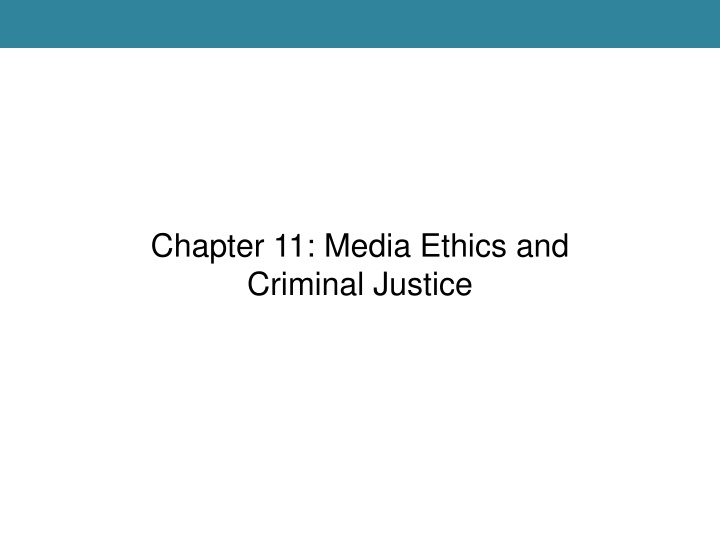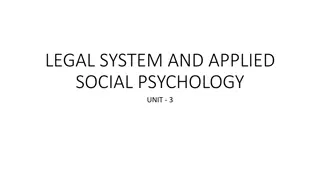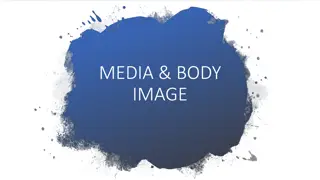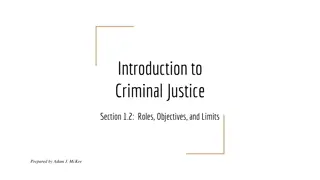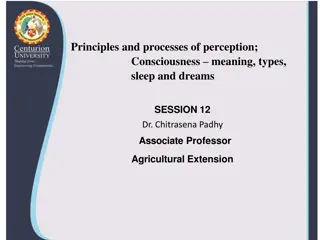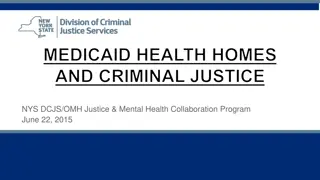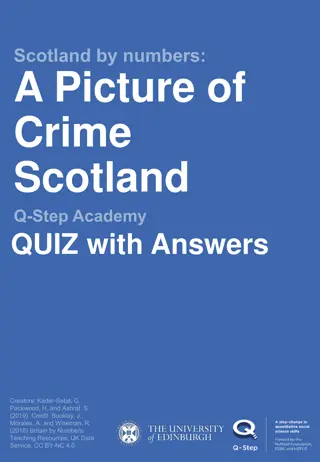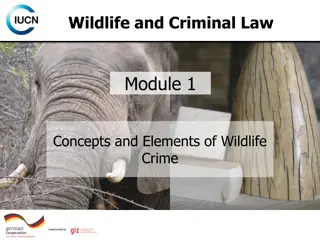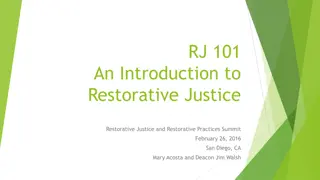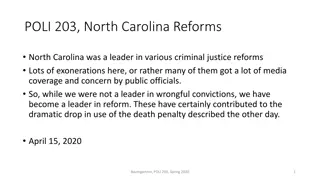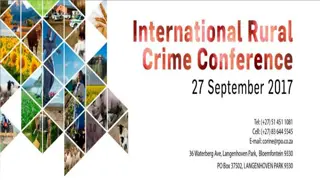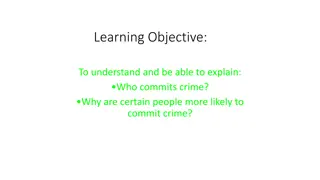The Influence of Media on Public Perception of Crime in Criminal Justice
Influence of the media on public opinion in criminal justice is significant. Media constructs crime narratives, shaping how people perceive causes of crime. Programs like CSI influence juror expectations on evidence, potentially affecting trial outcomes. The evolution towards ethics in journalism underscores the responsibility of journalists in reporting crime-related news.
Download Presentation

Please find below an Image/Link to download the presentation.
The content on the website is provided AS IS for your information and personal use only. It may not be sold, licensed, or shared on other websites without obtaining consent from the author.If you encounter any issues during the download, it is possible that the publisher has removed the file from their server.
You are allowed to download the files provided on this website for personal or commercial use, subject to the condition that they are used lawfully. All files are the property of their respective owners.
The content on the website is provided AS IS for your information and personal use only. It may not be sold, licensed, or shared on other websites without obtaining consent from the author.
E N D
Presentation Transcript
Chapter 11: Media Ethics and Criminal Justice
Influence of the Media Influence of the media cannot be doubted. Numerous studies have shown most people gain knowledge of events from media. News by the media is a critical element in forming and modeling public opinion on most topics, including criminal justice. Silverstone (2007) Suggests worldwide media, in age of globalization, constitute site for the construction of a moral order (p. 7). 2
Media Constructions of Crime Media decides what is newsworthy, and crime ranks high on that scale Jewkes (2011) Explains that media version of reality is determined by two factors a) Mediated portrayal of reality fashioned by news production processes b) Agenda-setting, that is, the assumptions of media professionals about their audience that cause them to select some items as newsworthy and others not are what determine how a story is framed 3
Media Constructions of Crime Media construction of crime will define what are thought to be causes of crime Surette (2011) Notes that in modern society, mediated crime event displaces actual event and the vicarious pleasure of reading about crime from place of safety and security is far preferable to being victimized 4
Media Constructions of Crime Programs like CSI influence juror expectations about evidence. Juror expectations of evidence that will be presented at trial shaped by multiple exposures to programming, to an extent that forensic evidence becomes reified and cannot be questioned. Legal system depicted as an obstacle to crime fighting with complex procedures and trials and dramatic adversarial contests In reality, there is little drama, few accused actually go to trial, and unexciting plea bargains are the norm (Surette, 2011) 5
Crime, Media, and Ethics Movement toward ethics in journalism began as early as the 1860s. Seven Canons of Journalism were adopted by 1923 by the American Society of Newspaper Editors Klaidman and Beauchamp (1987) Took view that journalists ought to make necessary ethical decisions themselves instead of adopting an approach that the journalist or broadcaster has absolute freedom to publish anything unless courts rule otherwise 6
Crime, Media, and Ethics Virtuous traits critical in a profession where stories are often produced in haste and under the pressure of events Propose cultivating moral virtues ought to be ongoing process within media so fundamental virtues are embedded and operationalized in stress situations The virtuous journalist has the following virtues: a) Truth, avoiding bias, avoiding harm, serving the public, maintaining trust, escaping manipulation, inviting criticism, and being accountable 7
Crime, Media, and Ethics Competence is key issue for media Absence or weakness is revealed when the journalist is unable to separate personal beliefs a) Can result in plagiarism in certain circumstances Can be general a) Can cover multitude of different tasks Can be specific a) Relates to specific context and defined task Is linked to responsibility 8
Reporting the Truth Reporting truth to public is fundamental to the role of media in society as well as moral responsibility of media. Concept of truth in journalism is not unproblematic. Klaidman and Beauchamp (1987) In covering stories where public s right to know is a determining factor, stories should a) Be substantially complete b) Encourage an objective understanding c) Be balanced and accurate 9
Reporting the Truth Cost is also a factor. Herman and Chomsky (as cited in Greer, 2010) Taking information from apparently credible sources minimizes investigative expense. Reporters must be both balanced and accurate. 10
Constructions of Rape Garland and others (2016) analyzed representations of rape in 30 comic books to determine which rape myths were reproduced Almost 1/3 of rape scenes reinforced the rape myth that rape is preventable by fighting back. Almost 1/3 of rape scenes supported the myth that failing to fight results in the raped person being responsible and blamed for the victimization. Myth that the victim s conduct brought about the rape was also endorsed. Comics supported the myth that rape is an outcome of a sexual desire. 11
Reporting the Truth Masculine assumptions commonly deployed by media to characterize women s experience of crime Either valorize or demonize them Madonna/Whore duality Enables such labeling of women Media perpetuates images dictated Women who kill commonly are framed by media as being extra deviant. Commonly portrayed as insane, emotionally unstable, domestic violence victims, sexual deviants, or bad mothers or wives 12
Law of Opposites Surette (2011) Nature of crime, criminals, and victims portrayed in media are generally the complete opposite of pattern shown through official crime statistics or victim surveys. 13
News-making Criminology Barak (1994) Aims to a) Demystify images of crime and punishment b) Affect public attitudes about crime and bring about a public policy based on structural and historical analyses of institutional development c) Allow criminologists to deploy their knowledge and be credible voices in public policy making on crime d) Call on criminologists to develop the necessary media skills to participate in dialogues on crime and justice 14
Reporting the Truth Elias (1994, 1996) Argued that media misrepresents the situation of crime victims by distorting causes and impact of victimization and by presenting victims as passive and vulnerable Media has been accused of perpetuating the image of an ideal victim by focusing attention only on victims who meet standard of victimhood (De Mesmaecker, 2010). 15
Reporting the Truth Media accounts that engender moral panics amplify deviance and function as advocacy for greater levels of social control. Media tend to deal in what Jewkes (2011) calls binary oppositions. To present events as choices between good and evil, guilt and innocence, and deviant, dangerous or sick as opposed to normal 16
Reporting the Truth Fear of crime and fear of being victimized by crime are key influences in criminal justice policy making and in the promotion of punitive policies. Many studies have found associations between media consumption patterns and measures of fear of crime. Surveys reveal majority of persons confirm they receive knowledge of risk of crime from media. 17
Avoiding Bias Bias is represented not simply by distortion of facts or information but also by a departure from objectivity informed by values of writer or editor. Should be distinguished from error Partisanship will only equate to bias in cases where underlying partisan values distort story. 18
Avoiding Bias News is constructed by the media who decide what is newsworthy. Often enhanced by sensationalist reporting Media representations of police using lethal force undoubtedly influence public perceptions of police Media often employ euphemisms designed to minimize or play down harm caused by police. 19
Avoiding Bias Hirschfield and Simon (2010) Contend that media stereotypically construct police as three types: a) Professional b) Vigilante c) Oppressor Victims of police violence are treated less sympathetically by media than other murder victims. 20
Media and Police Media representations of police using lethal force undoubtedly influence public perceptions of the police The output of police body cameras and the pervasive video filming of incidents involving police and citizens by bystanders have provided the news media with new sources of information about police practices. 21
Avoiding Harm John Stuart Mill Created the do-no-harm principle A person s liberty may justifiably be restricted to prevent harm that that person s actions would cause to others Concerns of journalist should include concern for public interest even when serving that interest results in harm to a public official Archard (1998) Notes that a clear distinction must be drawn between story being in public interest and story that interests public 22
Serving the Public Historical account of press freedom in U.S. reveals that in return for special privileges granted to it, the media is expected to provide a public benefit in form of timely, relevant, accurate information that informs the public understanding. Serving the public with news has shifted in meaning over time. 23
Serving the Public Surette (2011) Defines infotainment as marketing of edited, highly formatted information about the world in entertainment media vehicles Beginning from the late 1980s, crime-related infotainment began to appear on television and the boundary between crime and entertainment dissolved. CSI effect 24
Maintaining Trust Most urgent moral concern is securing and keeping the trust of the public. Truthfulness is fundamental to trust and is associated with fidelity and loyalty. Surveys of media credibility report: Almost every news organization/program had seen its credibility marks decline. Major broadcast news outlets credibility rating ranged between only 22% and 24%. Wall Street Journal rated higher (22%) than New York Times (18%) or USA Today (16%) 25
Manipulation Media power is formidable in political, economic, and social fields. When media attempt, in hard news, to persuade using emotional rhetoric rather than fact, it constitutes manipulation Manipulation is Any intentional and successful influence of people by non-coercively altering actual choices available to them or by non-persuasively altering other s perceptions of those choices. 26
Chapter Summary Articulation between media, crime, and ethics is complex and multifaceted. Nexus between crime and newsworthiness is well established. Media fuels moral panics and public fear of crime and distorts policy making. In terms of ethical responsibilities for reporting truth, media record is clearly imperfect. 27
